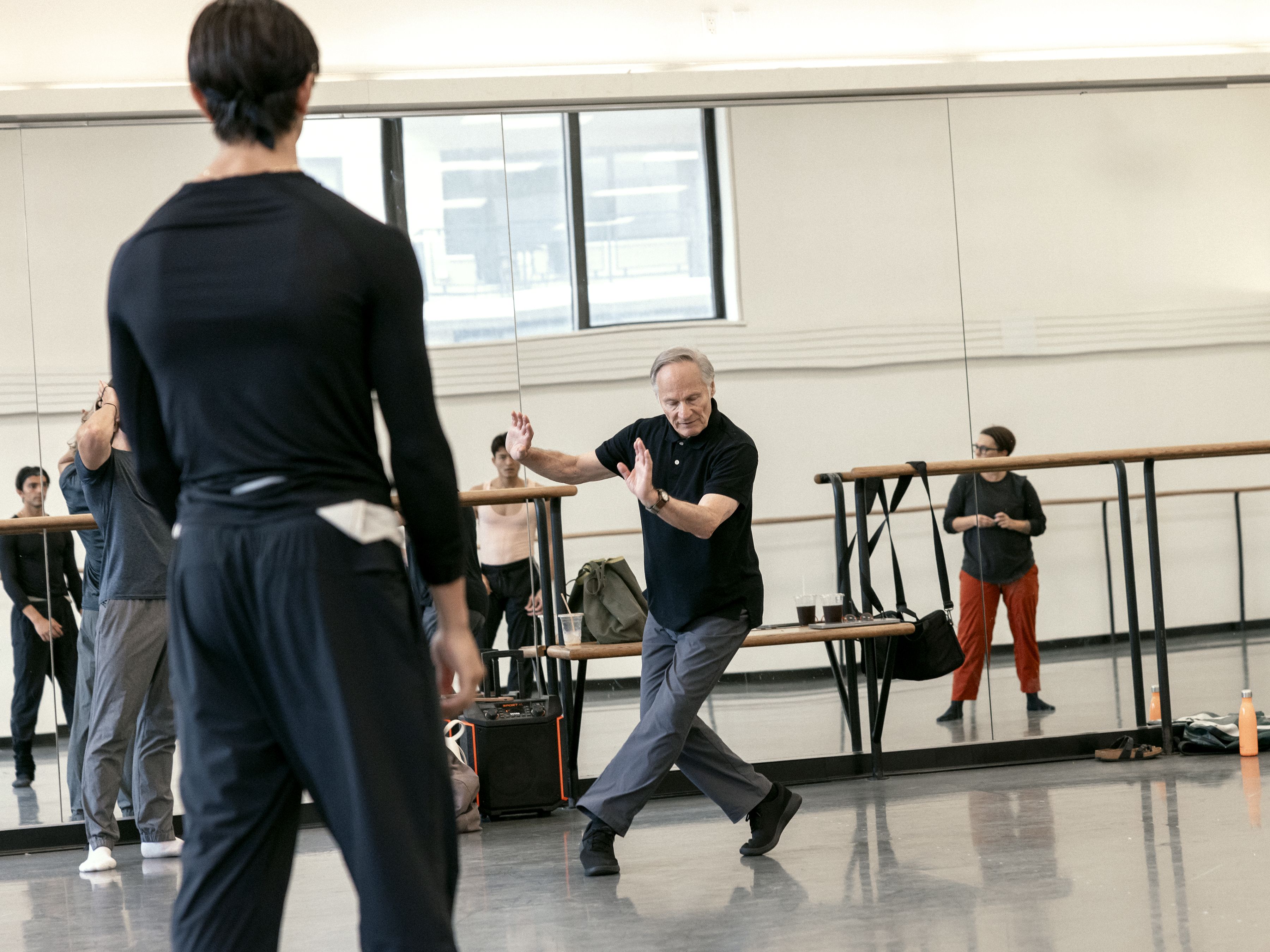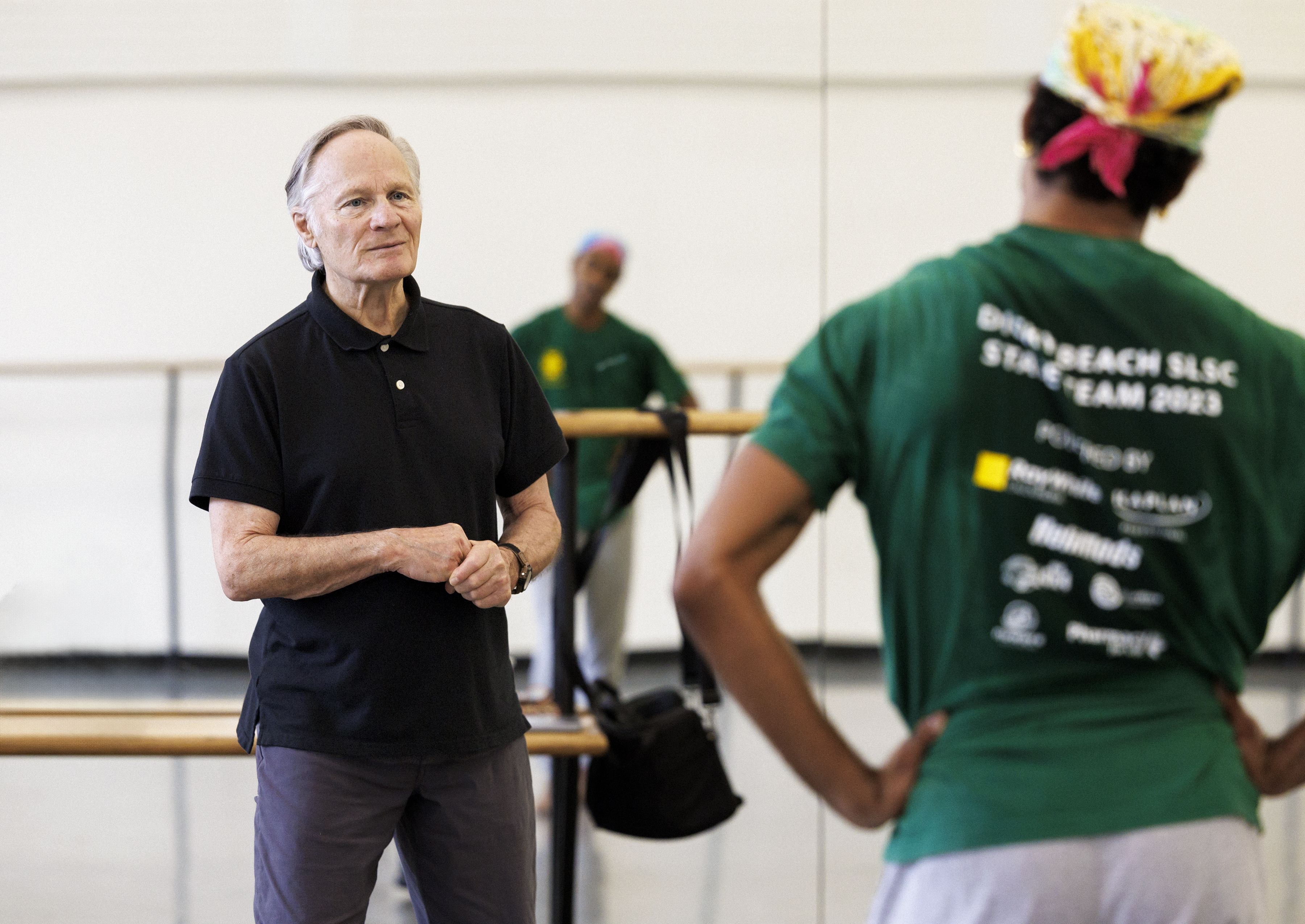
Becoming the Music
A Conversation with Choreographer Lar Lubovitch
, September 12, 2024
Premiering at New York City Center's 2021 Fall for Dance Festival, Lar Lubovitch's Each In Their Own Time creates an "intimate, luminous world," per Gia Kourlas in The New York Times, shared onstage by two dancers and a pianist performing three selections from Brahms’s Eight Piano Pieces, Op. 76. The work was created on Principal Dancers Adrian Danchig-Waring and Joseph Gordon amidst the COVID-19 pandemic, and though it represents a powerful response to the challenges of that moment, the choreography is timeless in its effects. We spoke with Lubovitch as he prepared to stage Each In Their Own Time for its NYCB debut this fall.
You’ve worked in a number of different genres and on countless different stages—including on the ice! Can you talk a little bit about how ballet fits into the picture, both in your career and in your choreographic voice?
I've always straddled a few genres at once. I came to dance rather late, at 19 years old, and when I began I studied all forms: ballet, jazz, and “modern.” It was all new to me, so it was all of equal interest. I didn’t view any form as hierarchical. I've maintained my connection to all of those movement feelings and imbued the vocabulary of ballet with those various other languages in my own way.
What inspires or excites you about working with New York City Ballet dancers?
From the time that I began dancing, I discovered early on that Mr. Balanchine’s work modeled the art of choreography and virtually taught us all how to make dances. For all the years I've been a dancemaker, I've returned to Balanchine often to be reminded of the basic and very sound essentials of what the craft is really about. But Balanchine also created a way of dancing. Being with New York City Ballet, of course, means being with the most highly trained, most highly expressive purveyors of that very particular movement feeling. I feel at home with them.
I’d love to hear about the creation of Each In Their Own Time. Please share what the process was like or any specific memories you have of rehearsing and creating the piece.
It was actually something to do during the late stages of COVID. Most of us were denied access to the work we really wanted to be doing and were looking for opportunities simply to create. [Principal Dancer] Adrian Danchig-Waring and I discussed doing a project, just for the sake of doing something, with no intent for it to be a piece to be performed or to have any specific conclusion. It was really just for the sake of working. We were fortunate enough to be given free studio space at City Center. [Adrian, Principal Dancer Joseph Gordon, and I] were required to test with a medical professional every morning, before we entered the building. We were either wearing masks or keeping a distance. And as we were working there, the directors of Fall for Dance asked if they could come down to see it. Consequently, they asked to debut it at Fall for Dance, the first “live” one in several years due to COVID, and that became, finally, its raison d'être. But originally it was just to create something for the sake of itself, to be in the process, to keep our spirits intact.
Can you describe your working process for a piece like this?
 I certainly don't come into the studio with a fully fleshed out idea. What I come in with is a piece of music and various thoughts and feelings about a way to embody it. Probably the closest way to describe it is as a way of painting a picture of the music in time and space. It really is about finding the visual and physical manifestation that expresses the shape, tone, and emotional condition of the music most explicitly. Sometimes there is an underlying story, or, actually, an overlayed idea to it, but at its basic heart it is really about making a dance about dancing—more specifically, about dancing as a way of “becoming” the music.
I certainly don't come into the studio with a fully fleshed out idea. What I come in with is a piece of music and various thoughts and feelings about a way to embody it. Probably the closest way to describe it is as a way of painting a picture of the music in time and space. It really is about finding the visual and physical manifestation that expresses the shape, tone, and emotional condition of the music most explicitly. Sometimes there is an underlying story, or, actually, an overlayed idea to it, but at its basic heart it is really about making a dance about dancing—more specifically, about dancing as a way of “becoming” the music.
There’s a little bit of a parallel with Mr. B in that approach.
Yes, it's clear to all of us that Balanchine has taught us how to “see” music. I have adapted and personalized that concept and expressed it in my own way, in search of my own voice. That has been my motivation.
Speaking of the music, I hadn't been familiar with the Brahms pieces before this, but I've really enjoyed listening to them. What drew you to this music?
I've had good fortune with Brahms. This is the fourth piece I've done to Brahms, and I've always had a very strong physical compulsion in response to his music. You might say it's music that creates a kind of kinesthetic energy for me. It makes me want to dance. In addition, it excites my inner eye so that I can see shapes that illustrate the way the music feels. Brahms wrote physically inclined music—music that's muscular.
I’ve seen Each In Their Own Time described as something of a sequel to one of your landmark works, Concerto Six Twenty-Two from 1986, most superficially because of the two male dancers and the somewhat similar costumes. Was that intentional on your part?
I don't think I intended that, but as I look back on it, and with regard to the observations of others, I do see it as a sequel—but I did not know that at the time. But as our unconscious mind is always working in tandem with our conscious mind, things are at play that we're not always aware of. It's good not to know. I like not knowing. Not knowing opens you up to a lot of things you might not otherwise discover. If you rely only on what you consciously know, it's a rather limited storehouse of repeatable ideas, but if you can take the risk of free falling through the imagination, you may, if you’re lucky, fall into something new.
Concerto Six Twenty-Two was choreographed at the height of the AIDS epidemic. It presented the proposition of two men together mutually supporting each other with grace and dignity in a time of crisis, when society in general objected strongly to that notion. These many years later, intentionally or not, Each appears to depict those same two people, having miraculously gained that right, allowing each other the grace and space to be themselves even while being together.
You’ve spoken and written about the duet as an art form; in thinking about this, I recalled a famous saying from Balanchine: “Two dancers on the stage are enough material for a story.” Can you say a little bit about the way you conceive of the duet?
 Yes, when two people are on a stage, it can't not be a story. No matter what the choreographer intended, no matter how abstract the motif, two people touching, caring, taking the days, weeks, it took to prepare a performance in order for it to be both free and safe—this is an emulation of freedom and democracy, really. In a duet one person's right to be free only goes so far as it does not impinge on the freedom of the other. When people dance together in a duet, they meet in that middle point where they are both free, and both safe. They have spent many hours arriving at that balance. Whether intentional or not you can’t extract the human drama from the endeavour of what they've done to be able to dance together.
Yes, when two people are on a stage, it can't not be a story. No matter what the choreographer intended, no matter how abstract the motif, two people touching, caring, taking the days, weeks, it took to prepare a performance in order for it to be both free and safe—this is an emulation of freedom and democracy, really. In a duet one person's right to be free only goes so far as it does not impinge on the freedom of the other. When people dance together in a duet, they meet in that middle point where they are both free, and both safe. They have spent many hours arriving at that balance. Whether intentional or not you can’t extract the human drama from the endeavour of what they've done to be able to dance together.
When the piece opens, the dancers start by watching the pianist who’s sharing the stage with them. So in some ways, it's like a trio between the pianist and the two dancers.
They're watching the pianist because it invites them and the audience to hear and feel the music in their own way first, before I essay my own particular point of view. It's a matter of taking a moment to acknowledge that the music is the inspiration for so much of the art that we create. The dancers and the pianist are in close touch with each other, of course, and that relationship is inherently woven into the dance.
As you revisit Each In Their Own Time three years after its debut, has the choreography or your thinking about it changed at all?
The choreography hasn't changed. All the steps are the same. What has changed is that I know much more about it. In reconstructing the work, it's more fully informed. When you're creating a piece, you're in discovery mode, and everything has yet to be researched. You put in front of you what appeals to your eye, what answers the needs of the ear, what looks right on the dancers; later, when you look back at all of it, you can inform it with much more insight.
What are you looking forward to about getting into the studio with the dancers?
I’m looking forward to working with these gifted dancers in the Company. Working with artists of that caliber is rewarding and humbling. To see my work essayed by dancers with Balanchine’s DNA in their souls is, needless to say, a personal pleasure.
Read Lar Lubovitch's remarks on the Art of the Duet, written for Lar Lubovitch at 80: Art of the Duet, presented by Works & Process at the Guggenheim Museum on December 3, 2023.
Rehearsal photos © Erin Baiano



